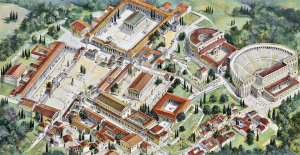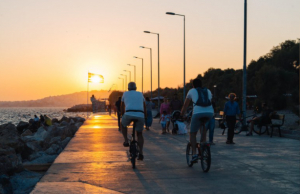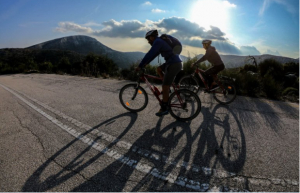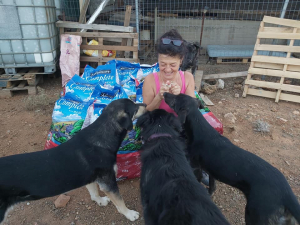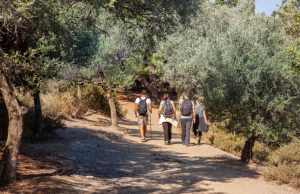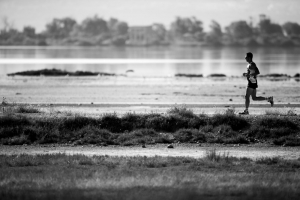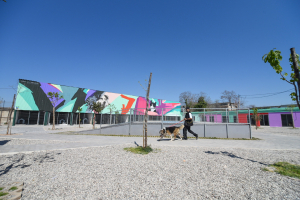Photo by: Manos Chatzikonstantis
LIFE & CULTURE
XpatAthens
The History & Importance Of The Ancient Agorá
In addition to being the civic center of Athens, the agorá was also a very sacred place - its architecture was brim with religious purpose. Centered around the Panathenaic Way, which was a sacred way serving as a route for the Panathenaic festival, the agorá was also famously known for housing the Temple of Hephaestus, and many other temples dedicated to Zeus, Athena, Apollo, and Ares.
Check out the fascinating video below about the history and importance of the ancient agorá.
Agorá Marketplace - A Space For Sharing Stories & Products By Greek Creators
Tips For Cycling In Athens
Ringed by mountains on three sides and with the coastline of the Saronic Gulf on the other, few capitals can compete with such majestic geography and a warm, dry climate that makes cycling a comfortable proposition all year round.
Your first Athenian cycling experience should start with the pedestrianised circle that rings the Acropolis, passing through Plaka, Anafiotika, Monastiraki, Thissio, and Koukaki, with a slight detour to pedal around the National Garden. Not only is this one of the most beautiful urban rides anywhere in the world, but it takes you on a journey through three millennia: from the ruins of Ancient Greek and Roman temples and monuments; Byzantine churches and Ottoman mosques; to the bustle of the modern city today.
To leave the centre behind and escape to the sea, you can take the 7-kilometre bike track that begins at Thissio Metro station. This entirely flat and traffic-free route is perfect for riders of all skill levels. After riding down Ermou, follow the green-painted track along the side of Metro Line 1, through the leafy and serene Athenian suburbs of Petralona, Kallithea, and Moschato. Follow the route of the ancient Ilissos River (now sadly buried beneath asphalt and apartment blocks) all the way to an incredible coastline reveal from the Stavros Niarchos Foundation Cultural Centre in Faliro. (But be careful not to miss the left turn across the bridge at Lamprou Katsoni.)
For more ambitious and independent riders, you can find incredible routes and challenging terrain in almost any direction. The near-1,000 metre Mount Ymittos can be reached by a grueling hour's climb from the city centre. Further afield, climbing Mount Pendeli gives you a thrilling descent down the other side towards the coast and beaches around Schinias. Tackling the formidable Mount Parnitha rewards you with an otherworldly, almost lunar landscape around the casino and an eerie, abandoned sanatorium.
Whether you've just arrived in town – or have been here for years – Athens always has new secrets to share!
Thank you This is Athens for your contribution as an XpatAthens Partner.
Mountain Biking on Mount Parnitha
Parnitha, one of three mountains that surround the Athenian basin, is by far the wildest. While the other two—Hymettus and Penteli—also have forested parts, you rarely feel as if you have really left the city. Parnitha, on the other hand, is a proper wilderness, a true “mountain’s mountain”.
The landscape is wild, with rocky hills covered in scrub in places, and dense, mature forests of fir and black pine in others. The weather is also different. There is a distinct touch of winter to the thinner air. The city is still visible, indeed the view is superb, but a hazy atmosphere makes it seem unreal, like a video game backdrop that you can see but never reach. All you can hear are the birds and the breeze.
A friend from This is Athens met with their guide Giannis at the Bafi refuge, an attractive mountain lodge where many of the mountain’s visitors end up for a warm bowl of soup or hearty sausages after a day out in the fresh air. Giannis could probably whip around the mountain before my first water break, yet, he adjusts to my pace while making it seem that he is doing no such thing, chatting knowledgeably about Parnitha’s flora and fauna.
Despite the devastating 2007 wildfire that ravaged much of Parnitha’s fir forest, the national park is home to roughly 1,000 species of plants, as well as animals large and small, including a large population of red deer. After many years of absence, wolves have even started to reappear on the mountain.
After a few kilometres on asphalt, we turn onto a dirt road through the forest. We cruise downhill, and my thrill at zooming through the trees is only slightly marred by the thought of what it’s going to be like to pedal back up. But every stretch is awash in natural beauty and every bend offers stunning views.
We’ve been riding for over two hours. At this point, Giannis often summons a van for his riders because the final stretch is all uphill. But it doesn’t seem much worse than what we’ve already encountered, so I decided that it would be a shame to complete our circuit in the back of a van. Citing an old Greek adage, I say: “We’ve eaten the donkey, all that’s left is the tail. Let’s do it.”
It is a big tail, one that is negotiated rather slowly and with gritted teeth. But, finally, we ride into the Bafi mountain refuge just as the sun is setting, feeling sweaty but accomplished.
To read this article in full visit: thisisathens.org
Photo by: Trekking Hellas
Thank you This is Athens for your contribution as an XpatAthens Partner.
Aphrodite & Loutraki's Landfill Dogs
In 2018 Afrodith created her Facebook page, The Loutraki Landfill Dogs so that people could see her work trying to help alleviate the suffering of the poor dogs. The smallest donation will help.
Read the full article on dogstodaymagazine.co.uk
Running Routes In Athens That'll Get You Sightseeing Too!
In the winter, you could be running in Athens’ “Central Park” of Philopappou, right below the Acropolis, with the historic hill all to yourself. What a treat!
One of Athens’ best-kept secrets, this 500 metre racetrack on the rim of the Panathenaic marble stadium (home of the first modern-day Olympic Games) boasts some of the city’s most spectacular views. Accessible only from the rear, through a green gate on Archimidous Street, it is very much open and free to use, as long as you don’t enter the actual stadium. Although this wonderful track can get crowded in the afternoons, it is very quiet in the mornings and truly magical to run along, taking in the views of the Acropolis, Lycabettus Hill, and the glowing white stadium below.
The location of choice for serious runners and probably the coolest place to jog in Athens. Imagine running all by yourself amongst wildflowers and catching cinematic glimpses of the Acropolis through clearings in the pine trees. Start at the entrance on Dionysiou Areopagitou walkway and turn left into the trees just before the church of St Demetrius. Try to follow the route to the old quarry and from there past the rock-climbing area. Meandering along the wall of rocks you will get to the landscaped stone path of Dimitris Pikionis that leads up to the monument of Philopappou on the summit. Take the opposite direction and rejoin the main path leading right. You will reach the wooden observatory and the dramatic seat of the ancient Pnyx, from where you can almost touch the Parthenon. This is what it would feel like to run in Ancient Greece (minus the sandals!).
Ladies Run, the first and only race exclusively for women in Greece, takes place every October. It has the added perk of following a breath-taking route by the sea, along Vouliagmeni’s pine-studded Laimos peninsula. Of course, you can enjoy the same route all year round, especially if you are staying in the southern suburbs near the sea. The Ladies’ Run starts in front of Astir Beach (Athens’ most elite beach) and moves up Apollonos Street as far as the tip of the peninsula, taking in some of the scenic promenades inside the swish new Four Seasons resort. Having enjoyed the splendid views, run back in the opposite direction to the marina. Follow the Ladies Run route along the marina, past the yachting extravaganza, and then retrace your steps back to the beach.
This large, under-visited park is on the way to the northern suburb of Kifissia (and close to the business hub of Maroussi if you are travelling to Athens for work). Apart from the fragrant pine trees that cover most of the park, Alsos Syngrou has other attractions such as a small pistachio grove, a vineyard, a theatre, a small lake, sports courts, and the city’s only Gothic Orthodox church, designed by the renowned Saxon architect Ernst Ziller. It is also a must-visit if you are training for the Athens Marathon: A full swing around the park is a tenth of the classic route, or 4.2 kilometres—ideal for clocking in long runs.
Your best bet for an easy run in the city centre, especially if you are staying around Syntagma and Kolonaki. The National Garden has many paths that are clearly mapped near each entrance. Attractions include ancient Greek columns, a Roman mosaic, rare century-old trees from around the globe, and a small animal enclosure. The best thing about running in the National Garden, apart from the downtown location, is that you never get bored with the routes on offer: an abundance of promenades, alleys, cul-de-sacs and lawns for stretching guarantee variety, though the layout is not ideal for those craving speed.
This content was originally published on This Is Athens
Written by: Anthony Grant
5 Scenic Hikes Around Athens
All five of these recommended routes are great any time of year, although spring and autumn offer the most comfortable temperatures. In winter, especially in the mountains, be prepared for cold and even snow. If hiking in summer, avoid the hottest part of the day (about 12.00 – 15.00) and take plenty of water and sun protection. Steer clear of particularly hot, breezeless days, and keep in mind that summer storms can suddenly roll in (especially in June).
1. Mount Ymittos (Kaisariani Monastery)
Best for: Hikers, mountain runners, anyone interested in Byzantine sights.
Why: Walking through the dense pine forest, you truly feel you are leaving the metropolis behind. There are also great picnic spots around the monastery.
How long: Allow about 2 hours to see the main sights and walk the prettiest paths.
Look out for: Behind Kaisiarani Monastery you'll find the curious, cavelike Analipseos Church with a pond inhabited by koi and frogs. Just behind that runs the Botanical Walk. Follow it north to a site called Kalopoula (also accessible by car) for a charming refreshment stand in the woods with a cold beer and cooked dishes. Be advised that it closes early, well before sunset.
Top tip: For one of the best views of the entire city of Athens, head to Taxiarches Hill (near Kaisariani Monastery).
How to get there: There are no nearby metro stops so the easiest way is to get a taxi directly to Kaisariani Monastery.
2. Alsos Syngrou
Best for: Runners, families.
The Route: About a 20-minute drive north of the city-centre lies a vast 230-acre green space known as Alsos Syngrou. “Alsos” in Greek means “urban forest”; while Andreas Syngrou was a wealthy banker and important 19th-century figure who bequeathed this entire expanse to, what is today, the Institute of Agronomic Sciences. About 50 acres are cultivated with crops such as grapevines, pistachio, and almond trees. The rest is mostly a wild expanse of pines and shrubs, scored with broad paths. You'll also find a dirt football pitch, basketball court and running track, and some grand buildings of the former Syngrou estate.
Why: When you’re in the heart of Alsos Syngrou, it feels quite wild—even though you’re still relatively close to the city. It's not as manicured as it could be, but it’s a lovely spot nonetheless for a nature fix without leaving town.
How long: A full circuit of the park will take between 1-2 hours, but there are various entrances, so you can tailor your visit to your energy levels.
Look out for: At the northeastern corner, among the ornate buildings of the estate, you’ll spy a small church designed by renowned architect Ernst Ziller. It’s Greece’s only gothic Orthodox church and looks like it's made out of fondant.
How to get there: Take Line 1 of the Athens Metro to the station KAT.
3. Tatoi Royal Estate
Best for: Hikers, history buffs, royal enthusiasts.
Why: The royals and aristocracy who summered here were no fools. It’s decidedly cooler than downtown thanks to the elevation, flowing streams, and lush green vegetation. The well-signposted paths make it an easy choice for a nature immersion with only the sounds of the wind and wildlife for company.
How long: Walking around the main palace grounds will take about an hour, although there are plenty of forest paths in the area for longer treks.
Look out for: For a deeper sense of Tatoi’s history, seek out the royal mausoleum and cemetery.
Top tip: The wider area is known for its country-style restaurants (taverna Agios Merkourios nearby is among the best and has a lovely view).
How to get there: Tatoi is not served by public transport, so access is only via a taxi or private/rental car—a 45 min drive from the city centre.
4. Sounion National Park
Best for: Adventurous souls, mineral enthusiasts, those who want to experience epic Sounio away from the tour buses.
The Route: Above the famed Temple of Poseidon, on the very tip of the Attica peninsula, stretches an expanse of forested hills that make up the Sounion National Park. The natural carpet of piney forest, shrubs, and wild herbs is lovely—but it’s geology that sets this region apart. Rich in mineral deposits, the area has been mined since antiquity—up until the 20th century, with valuable deposits processed and shipped from the nearby port of Lavrio—and remnants abound. One can hike through the national park from Lavrio on one stretch of the coast to Sounio on the other. Or drive directly to the village of Agios Konstantinos.
Why: As probably the least visited and developed national park in Attica, there’s an out-of-the-way wildness that makes a pleasant shift from the well-trodden tourist trails. Your reward will be stunning sea views over both sides of the peninsula.
How long: To hike the full distance from Lavrio to Sounio through the national park will take about 3-4 hours.
Look out for: The Chaos Gulch. This massive cavity in the earth, just outside the village of Agios Konstantinos, appears to have been created by the collapse of a huge underground cave. In Lavrio, stop by the Mineralogical Museum to learn how the area’s mineral wealth has been exploited since antiquity.
Top tip: Swimming in the sea directly underneath the Temple of Poseidon is arguably more magical than visiting the temple itself!
How to get there: KTEL intercity buses service both Lavrio and Sounio, so you can start at one end, and get a return bus from the other.
5. Parnitha
Best for: Dedicated hikers, although it's also great for families who want to introduce their kids to the wilderness.
The Route: Mt Parnitha is Attica's tallest mountain (reaching 1,413m) and its most “serious”. Driving from the city, the road climbs steeply before levelling out. After a number of turns, you reach the Bafi Refuge at an elevation of 1,160m. Despite a major wildfire in 2007, forested expanses in the area around the refuge have survived and there are myriad gorgeous routes for all levels of ability here—from short, easy walks to nearby springs, to challenging hikes to the mountain's peaks.
Why: You’d expect to travel much further from Athens to experience such an authentic alpine setting, with such diversity of flora and fauna. The Bafi refuge is highly accessible and offers a range of services, including guided hikes for kids and a restaurant serving up comfort cuisine with a view from up in the clouds. Parnitha has snow during most of the cold months lending itself to winter fun. In summer, it rarely climbs above 30 degrees, even on the hottest days, making for a revitalizing getaway.
How long: You can literally hike for days here (and sleep in the Bafi refuge). At the very least you will need half a day, taking into account travel time to and from the mountain.
Look out for: The mountain has rich wildlife including birds of prey, foxes, and even wolves in its more remote corners. Many of the animals are elusive, but you are quite likely to spot the red deer that live on the mountain.
Top tip: The relative proximity of Athens can create a dangerous complacency on Parnitha, and it’s worth remembering that it is a big mountain, with all of the inherent dangers. The weather can change abruptly, even in summer, and it’s easy to get lost.
How to get there: Aside from the road that leads up to the Bafi refuge (about a 1-hour drive from Syntagma), there is also a (free) cable car operated by the Regency Casino Mont Parnes, located on the mountain. You can get to the parking lot at the bottom by car, taxi, or public bus. From the casino, the Bafi refuge is about a 45-minute hike.
Photo by: Manos Chatzikonstantis
Run Messinia 2021: Run For Freedom
The 10 Historical Routes of Run for Freedom
The Messinian land constitutes a special and historic place for the Greek Revolution of 1821. For this reason, the event aims to highlight the history of all the areas associated with the Greek Revolution in Messinia both culturally and touristically.
- Run for Freedom will start its 1st route from Areopoli of the East Mani Municipality, pass through Stoupa of the West Mani Municipality and end in Kardamyli.
- The 2nd route, starting from Kardamyli, will pass through Verga of the Kalamata Municipality and end in the city of Kalamata.
- In the 3rd route, the athletes starting from Kalamata will cross Nedousa and finish in Alagonia.
- During the 4 th route of Run Messinia, the runners starting from Alagonia will pass through Dyrachio and Neochori of the Megalopoli Municipality and complete their effort in Poliani of the Kalamata Municipality.
- From Poliani, during the 5th route, participants will cross Skala and end up in Paloukorahi of the Oichalia Municipality.
- The 6th route will highlight historical places of the Oichalia Municipality, as the athletes starting from Paloukorahi will cross Katsarou, Solaki, Meropi, Loutro, Diavolitsi, Ano Psari, Dorio and end up at the statue of Kolokotronis in Ramovouni.
- In the 7th route starting from Ramovouni, the runners will pass through Zerbisia of the Messini Municipality, Kalogeresi, Saint Nikitas Sellas and Tripyla of the Trifylia Municipality, in order to reach Maniaki of the Pylos-Nestor Municipality.
- In the 8th route the participants will start from Maniaki, pass through Agios Andreas of the Messini Municipality and Kato Minagia and finish in Koroni.
- The 9th route will move exclusively within the Pylos-Nestor Municipality from Koroni, to Methoni and then to 2 Pylos.
- The 10th and final route of Run for Freedom starting from Pylos, will provide runners with the opportunity of passing through Neokastro, observing Sphacteria and Paleokastro, while crossing Kremmidia and Schinolakka.
Safety First
The event is planned and will be implemented based on the strict health and safety protocol and the approval of the Health Scientific Committee of the General Secretariat of Sports, with respect to the Covid-19 pandemic conditions. In order to avoid any excess interactions and overcrowding, up to 10 runners will compete in each route, while a Covid-19 test being mandatory for all. In case the epidemiological data improve, an increase in the number of participating runners will be considered. In case of a deteriorating health environment, the event will be transferred to the end of June.
The valuable support of the Municipalities
The partnered Municipalities supporting Run Messinia and contributing to the event’s smooth implementation are the following, in Greek alphabetical order: East Mani Municipality, West Mani Municipality, Kalamata Municipality, Megalopoli Municipality, Messini Municipality, Oichalia Municipality, Pylos-Nestor Municipality, Trifylia Municipality.
Run Messinia will leave a legacy for the future of the place, as it has already started highlighting and promoting through its social media, the historical places, the battles and all the monuments, which are located in the three regions and through which runners will pass.
The event will be held under the auspices of the Greek National Tourism Organization. The difficult task of the event’s planning and implementation has been 3 undertaken by the award-winning ActiveMedia Group through its Sports Production department.
More information on the schedule, routes, and details of Run Messinia will be announced in the upcoming weeks.

